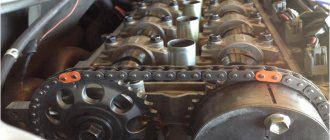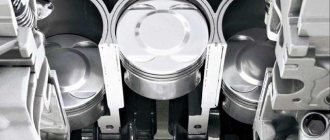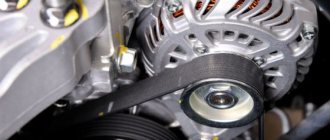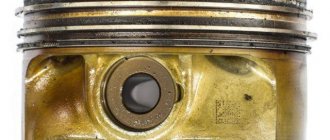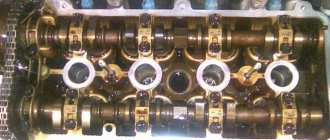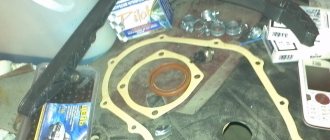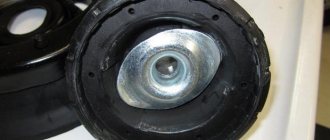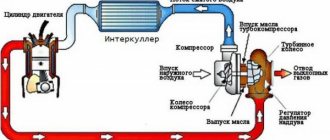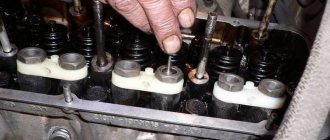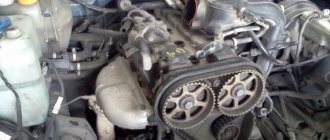Many car enthusiasts do not pay any attention to the smoke from the exhaust pipe of a gasoline engine. It smokes - it means it works. But a car exhaust system and a stove chimney are not the same thing. The presence of smoke emissions from the machine serves as an indicator of various problems.
At the same time, it is very advisable to notice them as early as possible and take appropriate measures in a timely manner. Delay in this case means a sharp decrease in engine life, wild oil consumption, malfunction of the cooling system, increased fuel consumption, deterioration in dynamics and other problems (both individually and all at once).
Cause of smoke in the exhaust pipe
In order to understand the question of why the engine smokes, you need to have an idea of what happens in it during operation.
A fuel mixture is formed in the combustion chamber, which is compressed by the piston and ignited by a spark from the spark plug. The mixture is supplied through the inlet valves, and the spent mixture is discharged through the outlet valves. The pistons have special oil intake rings; they are needed to collect excess oil on the cylinder walls so that it does not enter the combustion chamber.
The engine valves also have special seals (caps), which serve to ensure that the oil located in the cylinder head does not enter the combustion chamber. In addition, spark plugs also play an important role, and if they have a weak spark, or the gaps between the electrodes are incorrectly set, then the fuel mixture in the engine will not burn completely.
Based on this, we can identify the following causes of engine smoke.
- Spark plug . If the spark plugs are faulty, that is, they produce a weak spark, or the gaps between their electrodes are set incorrectly, then the fuel mixture does not burn completely and is discharged from the combustion chamber with blue smoke. In the most severe cases it may be black.
- Piston oil intake rings. As stated above, oil intake rings perform a function related to cleaning the cylinder walls of excess oil so that it does not enter the combustion chamber. They are subject to a powerful frictional force. If they wear out, the oil enters the combustion chamber and ignites along with the fuel mixture. In this case, black smoke appears. Similar functions are also performed by engine rings, which also remove excess oil from the surface of the cylinders and can wear out over time.
- Valve caps. These are seals that serve to prevent the oil in the cylinder head from entering the combustion chamber, and are made of dense rubber. When it wears out, the lubricant enters the combustion chamber and ignites. This produces white (or bluish) smoke.
The last two reasons for smokiness will be discussed below. If a car owner notices the appearance of blue or blue smoke, he needs to pay close attention to the operation of the power unit’s spark plugs and have them diagnosed or replaced.
You need to remember that sometimes the cause of smoke in the exhaust pipe can be bad gasoline. It may contain various additives or additives that will create black or other colored smoke. This problem usually disappears when refueling with other fuel.
Black smoke coming out
In some cases, smoke may be accompanied by the following symptoms:
- difficulty starting a cold engine;
- unstable operation of the engine both at idle and under load;
- inconsistency of tachometer readings (speeds fluctuate);
- increased fuel and engine oil consumption;
- loss of power of the power unit.
There are often situations in which engine smoking is the only warning sign.
The first thing you need to pay attention to is the color, shades and density of the smoke coming from the engine. The most common colors of the gases released are:
- White.
- Black.
- Bluish-gray.
Each of the listed smoke colors can have different shades, but this division into groups is the main one.
Why does the engine smoke? Car owners are often interested in this. The main malfunctions that cause increased smoke output from the exhaust pipe:
- damage occurring in the fuel supply system;
- wear of parts included in the cylinder-piston group;
- disturbances in the operation of the gas distribution mechanism;
- problems with the cooling system.
Smoke may appear when the quantitative air-fuel balance is disturbed, uneven mixing and incomplete combustion of the air-fuel mixture, or failures that occur when coolants or lubricants penetrate the combustion chambers.
Each of the reasons described can affect the shade of the smoke cloud emitted.
An experienced technician is able to take into account the impact of defects in one system on the incorrect operation of other components of the power unit. For example, problems that occur in the cooling system lead to overheating of engine components. Under the influence of ultra-high temperatures, the piston rings are destroyed, the seal is broken, oil and coolant penetrate the cylinders, burn, producing smoke of a certain color.
After capitalization, as a rule, the engine smoke stops.
The greatest damage to the environment is caused by clouds of black smoke coming out of a car's exhaust pipe or directly from the power unit. The most likely reasons for the appearance of such smoke lie in the following violations:
- malfunctions of the engine control system;
- disorder of adjustments in fuel equipment;
- reducing engine cylinder compression.
An imbalance between the number of components of the air-fuel mixture in the direction of increasing fuel causes not only the formation of black smoke, but also significantly increases fuel consumption. Failure of the normal mixture formation process may be caused by contamination of the air filter. A deficiency of air entails an excess of fuel when preparing the air-fuel mixture.
A decrease in the compression level can be caused by mechanical damage to the cylinders, which significantly reduces the power of the power unit and contributes to an increase in the concentration of fuel in the mixture.
Also interesting: Black exhaust, white exhaust, blue exhaust - reasons
To carry out accelerated diagnostics, it is necessary to examine the condition of the spark plugs. Black deposits indicate that there is a need to replace spark plugs with new samples, followed by repair of deformed elements and regulation of power unit systems.
Why does the engine smoke white gas with a bluish or blue tint? When researching the origin of gray or blue exhaust, the following reasons are most often cited:
- Damage to valve stem seals.
- The occurrence of rings designed to remove residual oil from the cylinder walls.
- Turbocharger malfunction.
- The oil used is of low quality.
The purpose of the caps is to hold the oil before it is supplied. Poor quality and malfunction of these elements lead to loss of tightness; lubricant constantly leaks and accumulates in the cylinders. As soon as you start a cold engine after a long break, the accumulated oil will burn together with the fuel in the chamber, blue or dark blue smoke will burst out of the car’s exhaust pipe in a huge cloud.
Wear and sticking of oil scraper rings leads to excess lubricant entering the engine cylinders and subsequent combustion. The use of the ring decarbonization method temporarily solves the problem, but in this case the rings lose their elasticity, and the occurrence may resume. To avoid serious damage to the power unit, it is necessary to constantly monitor the color of the exhaust gases.
With little wear of engine elements, a short-term release of blue smoke is observed during cold operation. As the motor heats up, the parts expand as a result of an increase in their temperature, which has a beneficial effect on the gaps between the mating surfaces of the elements. The smoke output decreases or disappears altogether.
Diagnosis of faulty engine oil rings
As stated above, if the engine smokes black, then the problem is that the piston oil rings are worn out and lubricants are leaking into the combustion chamber.
Ignoring this problem can lead to the fact that the rings will not remove the lubricant, and therefore it will need to be constantly refilled. In addition, the rings may become stuck and will need to be decoked. You can learn how to decarbonize stuck rings from other publications. But it is better to do this at a specialized service station.
Now let's move on to consider the question of how to diagnose this problem.
There are two ways, the first is a compression test, which will be discussed in detail below.
The second is diagnostics with the power unit running.
In order to determine the problem with the rings, it is imperative to warm up the engine to operating temperature, since this problem only appears when the power unit is running hot.
Then press the gas pedal, giving standard or increased speed. If black smoke comes from the exhaust pipe, then the problem is in the rings and they need to be replaced.
How to replace the piston rings in this case. Here you will have to disassemble the cylinder head, remove the pistons, buy a new set of rings and replace them. If the car is foreign-made, then it is better to entrust such work to specialists, since doing this without removing the engine will be problematic.
It is important to remember that if the problem is in the rings, then the engine will generally have difficulty starting after a long period of inactivity.
Gray
Blue smoke from the chimney means oil has entered the combustion chamber. This is the only exhaust color whose cause cannot be confused. If oil gets into the cylinder, then the problem is probably due to wear of the rings, cylinder-piston group, or fatigue of the valve stem seals.
If the emission of blue gas occurs when starting a cold engine, then most likely the problem is in the valve stem seals. Through them, oil slowly but surely accumulates in the cylinder, and then quickly burns along with the fuel, which provokes a large emissions on a cold start.
If blue smoke is constantly present, then it is worth checking the oil filler tank. The oil burner comes along with problems with the crankcase ventilation system. Due to a malfunction, the ventilation will force oil into the engine cylinder. Also, the car will smoke bluish smoke if the piston rings and cylinder walls are severely worn.
Diagnosis of faulty valve caps
If the engine smokes white, then the problem is in the caps. White smoke can also have a bluish tint. Based on this, the car owner urgently needs to change the seals on the valves, otherwise he will experience high engine oil consumption.
This problem can be detected when the engine is running cold, or while driving.
Let's consider the first case. The car enthusiast should park the car in a garage or other place and wait until the engine cools down. After this, put it in neutral gear and start the engine, giving speed.
When starting in this way, white or bluish smoke will pour out of the exhaust pipe. This means that oil enters the combustion chamber through the valve caps.
The second method requires the driver to be observant. When the car is moving, you need to accelerate it, then brake the engine, and press the gas pedal again, giving significant speed. In this case, you need to constantly look in the rearview mirror. If white or bluish smoke starts pouring out, then you can safely diagnose a faulty cap.
What to do in this case. This problem can be solved in your garage. You just need to remove the old seals and replace them with new ones. This type of work does not require great skills and even a beginner can handle it.
It is important to remember that if the car still smokes with replaced oil seals, then the problem may be in other engine components, so in this case it is better to contact specialists and carry out professional diagnostics.
Mitsubishi Lancer X muffler diagram
So, first, let's look at the exhaust system diagram. As you can see in the schematic diagram, the front exhaust pipe is connected to the exhaust manifold, and we take it as the beginning of the exhaust tract. Immediately after the front exhaust pipe, a catalyst is installed, the first lambda probe No. 1 is installed in it, then after the catalyst there is a central pipe, in which there is a built-in catalyst and lambda probe No. 2. This is followed by an additional muffler followed by a pipe to the main muffler.
The entire system has quite significant dimensions and would often be subject to shock loads if it were rigidly tied to any elements of the car, which is why it is suspended on special rubber mounts, and some connections are secured to each other through plastic connections - corrugations.
The main muffler is located at the rear of the car; it is a large “flattened rectangular can” connected to the central pipe by means of special bolts and springs. It is the main muffler that determines how loud the exhaust sounds.
The approximate dimensions of the main muffler are as follows: height - 135 mm, width - 270, length - 490. The diameter of the exhaust pipe varies depending on the modification of the car.
Diagnostics using compression
The above problems with the power unit can be identified through special diagnostics using a compression meter. This is a device that measures pressure. You can do such diagnostics in your garage.
To do this, you will need the help of a friend and the presence of the device itself.
To carry it out correctly, you need to adhere to the following algorithm. First you need to put the car in the garage and warm up its engine to operating temperature.
After this, disconnect the spark plug of the first cylinder and insert a compression gauge there. Using the starter, start the engine for a few seconds (crank the crankshaft), and remember the pressure that the device shows. Next, you need to pour no more than 20 grams of oil into the cylinder chamber and turn the crankshaft again. If the pressure in the first case is low, and in the second case it increases, then the problem is in the piston rings and they definitely need to be changed.
As you can see, there is nothing complicated in such a diagnosis, but it helps to identify one of the problems with the appearance of smoke.
It is important to remember that loss of engine power at high speeds or loads also indicates that the piston rings are worn out.
The reason for the appearance of smoke of different colors from the exhaust pipe may indicate several problems in the power unit. If they are diagnosed on time, then large deviations in engine operation will not appear. If you start it, then serious breakdowns may occur, and large costs for their correction may occur.
Quite often you notice that increased smoke appears from the exhaust pipe of a car. Sometimes situations get to the point where the car is literally shrouded in clouds of thick smoke. It is quite obvious that for every car enthusiast, the appearance of excessive smoke indicates the appearance of certain problems with the car.
Let us immediately note that not always, but often, increased smoke indicates serious problems. At the same time, it will not be difficult for experienced drivers to determine the cause by the color and composition of the exhaust. However, for beginners it is not always easy to understand why the engine smokes, as well as to determine the cause and identify the rings or caps. Let's figure it out.
Read in this article
The influence of the quality of the oil used on smoke formation
Motor oil must have certain characteristics. The quality of the lubricant used directly depends on its properties. If the car engine contains low-quality oil, the viscosity coefficient of which does not correspond to the car brand, or if the temperature inside the engine increases, a sharp loss of useful properties of the lubricant occurs, this leads to serious damage to the elements and systems of the power unit. If blue smoke appears, you need to check the oil for compliance and, if necessary, completely replace it.
The appearance of smoke can be caused by a number of other reasons - from the appearance of microcracks in the engine body to the use of the wrong type of fuel intended for a given engine brand. Each specific situation always has a solution when seeking help from qualified specialists.
Read news about the new Niva
- Replacing Niva Chevrolet bearings
- Front suspension diagram Niva 2121, 21214
- The Niva engine does not start. What to do?
- Do-it-yourself Niva 2121 elevator: drawings, dimensions
- Changing the oil in the Niva 21214 engine
- Disassembly and assembly of the Niva 2121, VAZ 2131 engine
- An alternative to the LADA 4×4 car. The most expensive, cheap and average “substitutes”
- What kind of diesel engine can be installed on the Niva?
Also interesting: Increasing engine power in the Chevrolet Niva
White or black smoke appears from the exhaust pipe
Let's start with the main types of smoke to better understand the problem. So, white smoke from the exhaust pipe is quite normal for warming up a cold engine. Moreover, it is a mistake to believe that it is smoke. It's actually steam. Water in vapor form is a natural product of the engine.
In an unheated exhaust system, this vapor partially condenses and becomes visible, and water usually appears at the end of the exhaust pipe. As the engine warms up, condensation decreases.
The colder the environment, the denser the vapor produced. At temperatures below 10 ° C, steam is formed even on a well-warmed engine, and in frosty temperatures of minus 20 - 25 degrees it acquires a thick white color with a bluish tint. Air humidity also affects the color and saturation of steam. The larger it is, the thicker the steam.
Note that if steam is visible in the warm season, it is quite possible that this is due to. Its shade depends on the composition of the coolant, weather, lighting, and also on the amount of coolant in the combustion chamber. Sometimes it can take on a bluish tint, resembling “oily” smoke. But, unlike oil smoke, which leaves a bluish mist in the air for a long time, steam quickly dissipates.
It is quite difficult for an inexperienced motorist to determine by appearance what is the source of the smoke. In this case, you can use a proven verification method. To do this, on a well-heated engine, it is necessary to briefly cover the cut of the exhaust pipe with a sheet of white paper, while the condensed steam in the form of drops of water, when it hits the paper, will gradually evaporate and will not leave obvious greasy marks.
If this simple test confirms that it is steam rather than oil smoke coming out of the exhaust system, action must be taken to correct the problem that is allowing coolant to enter the cylinders.
Most often, liquid can enter the cylinders through insufficient broaching (in winter, coolant leakage is often observed at the junction of the block and head), burnout, and less often as a result of the formation. By opening the radiator cap or, it is easy to identify the smell of exhaust gases and a film of oil on the surface of the coolant.
All problems associated with white smoke from the exhaust pipe require elimination of not only the direct causes, but also a mandatory check of systems that can affect their occurrence: the activation sensor, the clutch or the fan itself, the condition of the radiator, its plugs, hoses or connections. If white smoke and accompanying defects are noticed, then the car cannot be operated, as the defects progress quickly.
- Let's move on. Black smoke from the exhaust pipe indicates an over-enrichment of the fuel-air mixture or a deterioration in fuel combustion conditions. Therefore, we are talking about malfunctions. Such smoke is usually clearly visible against a light background and represents soot particles - products of incomplete combustion of fuel.
Black smoke is accompanied by high fuel consumption, often poor starting, unstable engine operation, high toxicity of exhaust gases, and often loss of power due to a non-optimal composition of the air-fuel mixture.
It is important to understand that monitoring symptoms and quickly identifying the problem will further reduce the cost of repairs and avoid serious and rapidly progressing damage to the internal combustion engine.
Blue smoke from the exhaust pipe of a gasoline engine
If blue or gray smoke constantly pours out of the exhaust pipe, then this is a clear sign of burning engine oil. It can only burn in combustion chambers, but it can get there in several ways. Most often, the rings on the pistons leak oil. In good condition, when the piston moves downwards, they should “drive away” the oil film formed there during the reverse movement. If the rings are worn out or “stuck,” an oil film appears on the cylinder walls during the power stroke (when the air-fuel mixture burns). The grease burns and the result is blue smoke.
The second “path” of lubrication into the combustion chambers can be through the valve system. The valve stem seals are responsible for its timely removal from there. If they are worn out, oil enters the cylinders, burns and smokes blue.
Any of these malfunctions spell trouble. Firstly, as the situation worsens, the car will eat oil in buckets. Secondly, an additive to the air-fuel mixture in the form of motor oil does not improve combustion at all, and therefore will negatively affect the dynamics and throttle response of the car. Fuel consumption per hundred will also increase exorbitantly. Well, if you don’t pay attention to the blue smoke from the exhaust pipe of a gasoline engine for a long enough time, sooner or later the latter will be left without a sufficient amount of lubricant, causing its service life to be reduced to the point of jamming.
Why are valve stem seals needed and how do they work?
The valve reciprocates due to direct contact with the timing camshaft. When it spins, an oil mist is created. In this case, the valve periodically enters the combustion chamber area, where the presence of a lubricant is unacceptable. Valve seals remove oil from the valve stem without allowing it to enter the cylinder block.
Over time, they age: the rubber loses its elasticity, the parts become hard and the lubricating fluid begins to leak into the combustion chamber. To avoid excessive wear of the oil seals, they must be replaced in time.
Dark gray or black
This color of exhaust gases most often indicates a decrease in compression in the cylinder, or incomplete combustion of fuel in the engine. Incomplete combustion occurs due to excess fuel entering the engine. In this case, dark smoke with a distinct smell of diesel fuel or gasoline will come out of the chimney. And if there is more air than fuel in the combustion chamber, then the smoke becomes thick and light, almost white. In such a situation, the reason should be sought in the tightness of the air intake system, or in the fuel supply system itself.
Signs of worn valve seals
If you manage to recognize the failure of these parts in time, you will be able to avoid more serious engine breakdowns (parts of the cylinder-piston group). Main symptoms:
Wear on the valve stem seals cannot be avoided: these components of the gas distribution mechanism operate under increased load. In just one minute, the valve manages to make 150-1200 “stroke” (cycles). Plus, the products are exposed to an aggressive environment: exhaust gases.
The question arises, when to change valve stem seals? If you bought a new car, then you need to do this after about 50-70 thousand kilometers (on imported cars, the mileage can be 180 thousand km or more).
If you ignore the above signs of oil seal wear, you should expect problems with the engine, namely:
- reduction in power (the car will pull worse) due to poor performance of oily spark plugs;
- “floating” speed at idle;
- When the speed drops, the engine may stall.
It is also worth paying attention to the dynamic characteristics of the car - for example, acceleration and fuel consumption. If these two parameters have not changed, then we can speak with a high degree of confidence about wear of the valve seals. The same is indicated by normal compression in the engine cylinders.
What does blue smoke from a car exhaust mean?
In today’s article we will tell you about blue smoke from a car’s exhaust pipe and what vehicle problems it indicates.
In the material we will talk about the main reasons for the appearance of blue exhaust gases from the muffler and what part of the car urgently needs repair or replacement. WHAT DOES BLUE SMOKE FROM A CAR EXHAUST PIPE SAY?
Good afternoon, in today's article we will tell you about blue smoke
from
the exhaust pipe
of a car and what problems of the vehicle it indicates.
In this article we will talk about the main reasons
for the appearance of
blue
exhaust gases
from the muffler and which part of the car urgently needs repair or replacement.
In addition, we will analyze in detail such basic vehicle defects as severe wear of piston parts
,
malfunction
or
natural wear of valve stem seals
and
wear of valves
, which can create a
blue to the exhaust gases
In any car, over time, failures and malfunctions of certain devices, as well as parts that can disrupt the stable operation of the car engine, may occur. Such failures or breakdowns are usually reflected in the color of the exhaust gases
vehicle.
Few car owners pay attention to the smoke
from
the exhaust pipe
, and especially its
color
.
However, it is the color of the exhaust gases
that may indicate a specific problem with a particular element
internal combustion
engine ICE
).
The colors of exhaust gases
are:
black
,
white
(
gray
) and
blue
, each of which determines a particular problem in a car engine or another important system.
So, let's begin to consider the pressing question of why blue smoke
from the exhaust pipe of a car.
1
.
Vehicle exhaust gases have a blue tint
One of the main reasons for the blue tint
exhaust gases from
the exhaust pipe
is the penetration
of engine oil
into the working area of the cylinders of a car
engine
.
Motorists
call
blue oil
” and they can be blue, light blue and hazy, white-blue. Each shade may indicate a specific problem in a particular engine system.
Smoke from an “ oil
” type exhaust pipe is usually accompanied by increased consumption of motor oil
engine
.
For example, if the consumption of motor oil
is half a liter per hundred kilometers, then
blue
may be visible when the vehicle accelerates, and if the consumption
of motor oil
reaches a liter per hundred kilometers, then this phenomenon occurs even when the car is idling.
When engine oil
reaches 1.5 liters or more per 100 kilometers, this indicates
complete wear
of some
internal combustion engine
; by the way, the shade of the exhaust gases in this case becomes
bright blue
, with clear contours.
Also note that the exhaust smoke is “ oil-based.
” type, in comparison with ordinary steam, is not able to dissipate in the atmosphere, because it contains a large amount of fatty components
of motor oil
, which come out of the exhaust pipe along with the exhaust gases of the vehicle. Oily components in exhaust gases sometimes make up up to 45-50 percent of the total composition of exhaust gases, so they are physically unable to dissipate in the atmosphere.
2
.
Reasons for the appearance of blue smoke from the exhaust pipe of a car
A fairly common reason for the appearance of blue smoke
from the exhaust pipe of a car is severe
wear of the cylinder-piston group
of vehicle parts.
As a rule, in this case, wear occurs on the upper type compression rings
in the outer and inner surfaces, which are in direct contact with the working area
of the engine cylinder
.
In addition, the cause may be increased wear and the formation of grooves in the rings
the piston
itself .
In this case, parts such as valve stem seals
may be fine, but engine oil will penetrate into the working area
of the cylinders
, since
rings
constantly pump oil from the lower level to the upper.
the compression level usually decreases
and an increase in
crankcase
with increased wear of
the cylinder-piston group
engine
parts .
It is necessary to take into account the fact that the increased volume of engine oil, which penetrates into the working area of the cylinders
, perfectly closes the holes in the parts.
If the holes are sufficiently large in size, then, as a rule, engine
compression indicators are at the optimal level.
The above circumstance very often makes it difficult to find the main reason for the appearance of
blue
smoke
from the exhaust pipe .
Often in new cars you can notice when the engine warms up.
the exhaust gases coming out of the pipe
have a bluish tint
, which gradually decreases and disappears as the engine heats up.
The thing is that when the engine
up to operating temperature, the engine elements slightly change their external structure and find optimal places to fit against each other.
But with high wear of engine parts,
the situation is the opposite, namely: there is an increase in smoke output from the exhaust pipe on an already warmed up
engine
, all this happens due to the fact that heated engine oil has a weak viscosity and it is easier for it to get into the working area of the cylinder through worn out engine components.
In addition, one cannot help but note the fact that often the smoke coming out of the exhaust pipe has a bluish tint
, as well as increased engine oil consumption, is directly related to increased
wear of valves
and
guide
bushings of valve stem seals
.
These points increase the level of smoke as the engine
up, since the engine oil, which has reached operating temperature, becomes too liquid and light, and as a result it penetrates into the cracks between the aged elements of
combustion engine
.
In conclusion, we note that according to statistics, blue smoke
from the exhaust pipe of a car can also occur due to unstable operation
ignition system
or poor layout and design of
the engine valves
.
If the reason is in the valves, then the tint of the exhaust gases
becomes
bluish
.
This is very typical for a valve
that has severe
carbon deposits
or even
burnout
.
This problem can be quickly determined by measuring engine compression
in each individual
cylinder
.
As a rule, the compression
in
the cylinders
will be weak or completely absent, while the
spark plugs
will have a strong ash deposit and darkening.
Video review: “Blue smoke from the muffler. Causes and malfunctions”
We hope that our article helped you understand what the blue tint of exhaust gases from a car exhaust pipe indicates. Note that there are not many reasons for the appearance of exhaust gases with such a tint and, as a rule, they are all directly related to the incorrect operation of the internal combustion engine In addition, we strongly do not recommend operating a vehicle with blue emissions, as this can lead to even greater problems, such as increased engine oil consumption, decreased engine compression and, as a consequence, major repairs of the internal combustion engine.
THANK YOU VERY MUCH FOR YOUR ATTENTION. LEAVE YOUR COMMENTS AND SHARE WITH YOUR FRIENDS.
WE ARE WELCOME TO YOUR FEEDBACK AND SUGGESTIONS.
Replacing valve stem seals
The duration and complexity of this process depends on the make of the car and the specific model. But the general principles of replacement can be outlined. To successfully replace valve stem seals without removing the head, you must:
- Cool the engine completely and remove the valve cover.
- Make sure the marks on the pulley, camshaft and crankshaft match.
- Loosen the drive and remove the camshaft.
- “Dry” the valve springs (it is better to use a puller).
- Using pliers or a special collet, remove the valve seals.
- Take new products and lubricate their inner surface with engine oil. The same must be done with their seat.
- Place the valve seals onto the stem and press them in using gentle blows with a rubber hammer.
- Put the springs back and “dry” them.
If there are suspicions that the valve stem seals have not been changed for a long time, you will have to remove the cylinder head and clean the elements of the cylinder-piston group from carbon deposits.
Replacing caps on a VAZ 2121 (16 valves)
It is best to carry out this operation on a removed cylinder head. But if this cannot be done, you can replace the valve seals with your own hands on the spot. You need to prepare in advance:
When everything is ready, you can proceed directly to the process. The algorithm of actions is as follows:
- Disconnect the positive terminal from the battery, remove the high-voltage wires and unscrew the spark plugs.
- Set the top dead center as you do when changing the timing belt (the marks on the camshaft, pulley, and crankshaft must match).
- Take a 12 mm socket wrench and remove the valve cover.
- Pull out the plugs connected to the blocks.
- Remove the ignition coil.
- Remove the throttle (if it is dirty, take the opportunity to clean it).
- Remove the valve cover and remove the screws that secure the rocker arms (pull them out too).
- Take the compressor and “dry” the valves, first wrapping the device in a rag so that the valve retainers do not fly apart in different directions. One part of this device is stationary, and the other presses on the valve plate, simultaneously compressing the spring and releasing the “crackers”.
- If the valve goes into the combustion chamber when a tool is applied to it, then a wooden block or similar device will have to be inserted into the spark plug hole to stop the valve.
- Remove the worn oil seals from the bushings and press on new ones. Reassemble in reverse order.
It is worth taking seriously the choice of valve stem seals for the VAZ2112. Experts recommend the following kits:
- 2112-1007026: these are original products produced by AvtoVAZ and installed on the conveyor - ideal for Russian cars;
- setMaster-sport;
- Herzog;
- Trialli;
- STD "Reserve";
- Goetze: It’s worth taking a closer look at this manufacturer. Most experts prefer these products, despite the higher cost. The fact is that valve seals from this company are easier to install (the risk of damage is minimized) and they last longer even than the original VAZ ones.
When purchasing oil seals for a foreign car, you need to take into account the design of the caps. For example, on Japanese products there is a protrusion inside that matches the corresponding groove on the sleeve.
It is clear that such valve seals cannot be installed on European, American or Russian cars. It is worth noting that removing and installing valve stem seals with your own hands will cost less, even taking into account the purchase of a desiccant, than a trip to a car service center. If it is not possible to immediately replace the valve stem seals, then you can try to delay the inevitable repairs by using special additives. They are able to temporarily seal the gaps between the valve and its seal. Car chemicals of this kind will be cheaper than replacing caps (even on your own): it allows you to continue to use the car for some time. The most commonly used additives include:
- Wagner (USA);
- Liqui Moly (Germany);
- "Lavr" (Russia).
Why you shouldn't drive with worn valve seals
When lubricant enters the combustion chamber, fuel and lubricants are mixed, as a result of which the oil begins to turn into a combustion product and settle on the electrodes of the spark plugs in the form of black soot. As a result, sparking becomes unstable, the engine operates unsteadily and does not develop full power. Contaminated spark plugs will sooner or later lead to failure of one of the cylinders. Another impending problem is burnout of one or more valves. This is also fraught with cylinder failure and a sharp increase in oil consumption.
Insufficient valve closure leads to the appearance of varnish deposits in the cylinder head and on the piston group.
Criteria indicating oil seal wear:
- regular appearance of carbon deposits on spark plugs;
- increased engine oil consumption;
- lack of stable idle speed;
- with a sharp increase in speed, there is a profuse release of bluish smoke.
Maintenance includes regular replacement of oil, air, oil and fuel filters. Valve seals are designed for vehicle operation up to 100,000 km. In fact, replacement has to be carried out before the specified resource.
Black smoke from the exhaust pipe of a gasoline engine
Many people mistakenly believe that black smoke is the result of burning motor oil. In reality this is not the case. Black smoke, as mentioned above, comes from gasoline that has not burned properly. It may not burn out for several reasons. But the main one is an enriched air-fuel mixture. Gasoline simply does not have enough oxygen to completely burn out.
As many have already guessed, the “dog is buried” in the engine power system. This can be either a carburetor or a modern injection system. If the carburetor on your car is responsible for preparing “food for the engine,” it needs to be checked for wear, cleaned and adjusted. With the injection system it is a little more complicated, since electronics “rule the roost” there. Anything can lead to an enriched air-fuel mixture - faulty sensors, carbon deposits, a malfunction in the on-board computer, and so on. By the way, not only the components of the power system may be to blame. If there is a fault outside of it, but where there is a sensor, the electronics will be “confused” and incorrect “indications” will be sent to the injectors.
The consequences of operating an engine in which a rich air-fuel mixture is regularly burned are as follows:
- increased gasoline consumption;
- soot formation on spark plugs;
- reduction in engine power;
- carbon deposits on pistons and valves;
- unstable idle speed;
- “dull” motor.
By the way, the “culprit” of black smoke from the exhaust pipe of a gasoline engine is not in 100% of cases the power system. The problem could also be misfires. This is when, due to a malfunction of the ignition system, a spark is formed “every time”. As a result of this, not all the fuel burns out during the next power stroke, and black smoke from the exhaust pipe is accompanied by what motorists call “motor trouble.”
Installation of oil seals (valve seals)
The oil seal has the shape of a cylinder with a truncated cone. For tight contact with the surface of the valve guide, a polymer ring with an expander spring is provided. A plastic (or rubber) ring removes excess oil when the valve stem moves, and the spring allows it to be tightly fixed to the stem.
For a long time, a rubber ring was used in the design of the oil seal. Options made of rubber and fluoroplastic have appeared recently. This is due to the fact that rubber hardens faster and loses its properties. Manufacturing the ring using modern polymers extends the service life of the seal.
Purpose of valve stem seals
Long-term uninterrupted operation of the internal combustion engine is ensured by high-quality lubrication of rubbing parts. The oil distribution mechanism provides a small volume of oil. The camshafts in the cylinder head and the piston group require constant lubrication. The shaft rotates and a cloud of oil forms around it. The amount of lubricant is regulated by valve stem seals.
Carbon deposits on the valve surface lead to incomplete closure and the appearance of a gap. In the combustion chamber, the combustible mixture ignites, and excess oil settles in the form of varnish deposits. When the valve is lowered, the stem seal prevents excess oil from entering. Protects the piston group from deposits that occur during the combustion of oil and fuel mixture. Oil seals are classified as consumable items, as they require periodic replacement.
Signs of wear on valve stem seals
You can find out about the need for replacement without disassembling the engine. The valve stem seals have the following signs of wear:
- excessive oil consumption;
- bluish smoke;
- carbon deposits on spark plugs.
When oil seals wear out, oil consumption increases. This also happens when the piston group is “coked,” but there is a visual difference. Oil streaks are noticeable on the breather pipe. The emission of bluish smoke is a sign that oil is entering the combustion chamber. “Trippling” of the engine and carbon deposits on the spark plugs are caused by oil leakage through the rod seal. The car needs diagnostics and replacement of oil seals.
The service life of oil scrapers does not depend on the price and manufacturer. For budget and “premium” cars, the service life is calculated for a mileage of up to 100,000 km.
Clear smoke from the exhaust pipe
The steam coming out of the engine can be mistaken for white smoke. Steam is formed during the evaporation of accumulated liquid in cooled engine systems. Most often, the accumulation of liquid at the end of the exhaust pipe and the release of steam are observed in the cold season after starting the engine.
The engine and exhaust system components heat up and water evaporates rapidly. After the engine and exhaust system have completely warmed up, the amount of steam is reduced to a minimum or disappears completely.
The amount of steam released depends on the humidity levels in the environment; the higher they are, the longer its traces will be visible. The release of steam is not a sign of breakdown of engine parts and components; if this effect occurs, repairs are not required.
Also interesting: Popping noises in the muffler: what serious engine problems do they indicate?
Procedure for replacing valve stem seals
- Disconnecting the air filter, removing the cover and air ducts. The pipes and technical openings are closed with plugs. Unscrew the spark plugs and cylinder head bolts.
- The piston in the first cylinder is set at top dead center. Removing the lock washer and star. The valve locknuts are loosened, and the control nuts are unscrewed until they stop.
- The crackers and springs are removed. The seals are removed using a puller. The bushings are lubricated with oil, placed on the rod and installed with a hammer and socket.
- Reassemble the components and parts in the reverse order. Afterwards, using a similar algorithm, the remaining caps are changed in the order of cylinders 4 - 2 - 3.
To service each cylinder, the crankshaft needs to be rotated 180 degrees.
Self-replacement will require a special tool. The main specific device is a valve desiccant. You will need it to replace the valve seal. Devices and materials:
- sets of socket and socket wrenches;
- extension cord with heads;
- rod and hammer;
- Collet clamp;
- press frame;
- tweezers;
- head gasket;
- a set of new caps;
- sealant.
During the work, it is possible to replace the gaskets under the block and cylinder head. New oil seals are selected for a specific engine model.
